Macau
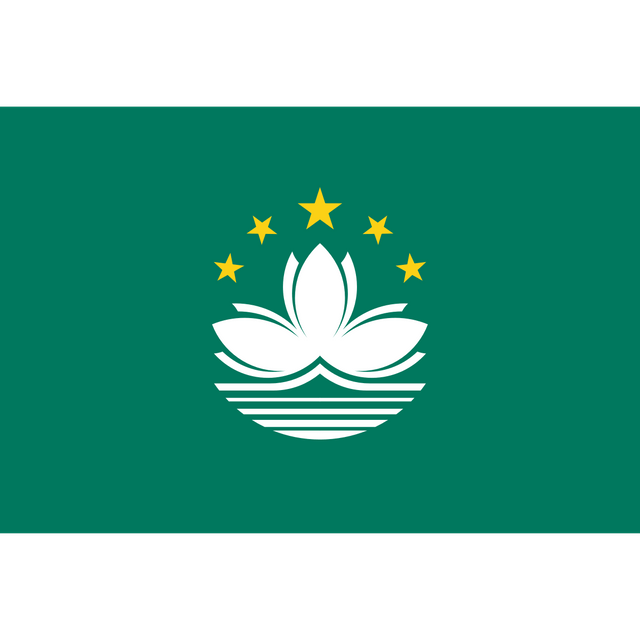
Macau

Macao Special Administrative Region of the People's Republic of China
| |||||||||||||||||||||||||||||||||||||||
|---|---|---|---|---|---|---|---|---|---|---|---|---|---|---|---|---|---|---|---|---|---|---|---|---|---|---|---|---|---|---|---|---|---|---|---|---|---|---|---|
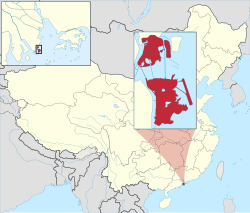 Location of Macau | |||||||||||||||||||||||||||||||||||||||
| Official languages | |||||||||||||||||||||||||||||||||||||||
| Regional language | Cantonese[1] | ||||||||||||||||||||||||||||||||||||||
| Official scripts | Traditional Chinese[2] Portuguese orthography | ||||||||||||||||||||||||||||||||||||||
| Ethnic groups (2016) | 88.4% Chinese 4.6% Filipino 2.4% Vietnamese 1.8% Portuguese or Macanese 2.8% other[4] | ||||||||||||||||||||||||||||||||||||||
| Demonym(s) | Macanese | ||||||||||||||||||||||||||||||||||||||
| Sovereign state | China | ||||||||||||||||||||||||||||||||||||||
| Government | Devolved executive-led system within a socialist republic | ||||||||||||||||||||||||||||||||||||||
• Chief Executive | Fernando Chui | ||||||||||||||||||||||||||||||||||||||
• Administration and Justice Secretary | Sonia Chan | ||||||||||||||||||||||||||||||||||||||
• Assembly President | Ho Iat Seng | ||||||||||||||||||||||||||||||||||||||
• Court President | Sam Hou Fai | ||||||||||||||||||||||||||||||||||||||
| Legislature | Legislative Assembly | ||||||||||||||||||||||||||||||||||||||
| National representation | |||||||||||||||||||||||||||||||||||||||
| 12 deputies(of 2,924) | |||||||||||||||||||||||||||||||||||||||
| 29 delegates[5] | |||||||||||||||||||||||||||||||||||||||
| Special administrative regionwithin the People's Republic of China | |||||||||||||||||||||||||||||||||||||||
• Portuguese settlement | 1557 | ||||||||||||||||||||||||||||||||||||||
• Sino-Portuguese Treaty of Peking | 1 December 1887 | ||||||||||||||||||||||||||||||||||||||
• Sino-Portuguese Joint Declaration | 26 March 1987 | ||||||||||||||||||||||||||||||||||||||
• Transfer of sovereignty from Portugal | 20 December 1999 | ||||||||||||||||||||||||||||||||||||||
| Area | |||||||||||||||||||||||||||||||||||||||
• Total | 115.3 km2(44.5 sq mi) | ||||||||||||||||||||||||||||||||||||||
• Water (%) | 73.7 | ||||||||||||||||||||||||||||||||||||||
| Population | |||||||||||||||||||||||||||||||||||||||
• 2017 estimate | 667,400[6] (167th) | ||||||||||||||||||||||||||||||||||||||
• Density | 21,340/km2(55,270.3/sq mi) (1st) | ||||||||||||||||||||||||||||||||||||||
| GDP(PPP) | 2018[7] estimate | ||||||||||||||||||||||||||||||||||||||
• Total | $78.1 billion (95th) | ||||||||||||||||||||||||||||||||||||||
• Per capita | $118,098 (2nd) | ||||||||||||||||||||||||||||||||||||||
| GDP(nominal) | 2018[7] estimate | ||||||||||||||||||||||||||||||||||||||
• Total | $53.9 billion (83rd) | ||||||||||||||||||||||||||||||||||||||
• Per capita | $81,585 (3rd) | ||||||||||||||||||||||||||||||||||||||
| HDI(2017) | very high · 17th | ||||||||||||||||||||||||||||||||||||||
| Currency | Macanese pataca (MOP) | ||||||||||||||||||||||||||||||||||||||
| Time zone | UTC+8(Macau Standard Time) | ||||||||||||||||||||||||||||||||||||||
| Date format | dd-mm-yyyy yyyy年mm月dd日 | ||||||||||||||||||||||||||||||||||||||
| Driving side | left | ||||||||||||||||||||||||||||||||||||||
| Calling code | +853 | ||||||||||||||||||||||||||||||||||||||
| ISO 3166 code | MO | ||||||||||||||||||||||||||||||||||||||
| Internet TLD |
| ||||||||||||||||||||||||||||||||||||||
| Macau | |||||||||||||||||||||||||||||||||||||||
 "Macau" in Traditional (top) and Simplified (bottom) Chinese characters | |||||||||||||||||||||||||||||||||||||||
| Chinese name | |||||||||||||||||||||||||||||||||||||||
| Traditional Chinese | 澳門 | ||||||||||||||||||||||||||||||||||||||
| Simplified Chinese | 澳门 | ||||||||||||||||||||||||||||||||||||||
| Literal meaning | Bay Gate | ||||||||||||||||||||||||||||||||||||||
| |||||||||||||||||||||||||||||||||||||||
| Macau Special Administrative Region | |||||||||||||||||||||||||||||||||||||||
| Traditional Chinese | 澳門特別行政區 (or 澳門特區) | ||||||||||||||||||||||||||||||||||||||
| Simplified Chinese | 澳门特别行政区 (or 澳门特区) | ||||||||||||||||||||||||||||||||||||||
| |||||||||||||||||||||||||||||||||||||||
| Portuguese name | |||||||||||||||||||||||||||||||||||||||
| Portuguese | *Região Administrativa Especial de Macau [ʁɨʒiˈɐ̃w ɐdminiʃtɾɐˈtivɐ (ɨ)ʃpɨsiˈal dɨ mɐˈkaw] | ||||||||||||||||||||||||||||||||||||||
Macau or Macao (/məˈkaʊ/ (listen); 澳門, Cantonese: [ōu.mǔːn]; Portuguese: [mɐˈkaw]), officially the Macao Special Administrative Region of the People's Republic of China, is a special administrative region of China on the western side of the Pearl River estuary in southern China. With a population of 667,400[6] and an area of 32.9 km2 (12.7 sq mi), it is the most densely populated region in the world.
Macau was formerly a colony of the Portuguese Empire, after Ming China leased the territory as a trading post in 1557. Portugal governed the area under titular Chinese sovereignty and authority until 1887, when it was given perpetual colonial rights for Macau. The colony remained under Portuguese control until 1999, when it was transferred to China. As a special administrative region, Macau maintains separate governing and economic systems from that of mainland China.[9]
Originally a sparsely populated collection of coastal islands,[10] the territory has become a major resort city and the top destination for gambling tourism. It is the ninth-highest recipient of tourism revenue and its gaming industry is seven times larger than that of Las Vegas.[11] Although the city has one of the highest per capita incomes in the world, it has severe income inequality.[12] Its GDP per capita by purchasing power parity is one of the highest in the world and higher than any country in the world in 2014 according to the World Bank.[13]
Macau has a very high Human Development Index. The government of Macau calculates its own HDI.[8] Macau has the fourth-highest life expectancy in the world.[14] The territory is highly urbanised and most development is built on reclaimed land; two-thirds of total land area is reclaimed from the sea.[15]
Macao Special Administrative Region of the People's Republic of China
| |||||||||||||||||||||||||||||||||||||||
|---|---|---|---|---|---|---|---|---|---|---|---|---|---|---|---|---|---|---|---|---|---|---|---|---|---|---|---|---|---|---|---|---|---|---|---|---|---|---|---|
 Location of Macau | |||||||||||||||||||||||||||||||||||||||
| Official languages | |||||||||||||||||||||||||||||||||||||||
| Regional language | Cantonese[1] | ||||||||||||||||||||||||||||||||||||||
| Official scripts | Traditional Chinese[2] Portuguese orthography | ||||||||||||||||||||||||||||||||||||||
| Ethnic groups (2016) | 88.4% Chinese 4.6% Filipino 2.4% Vietnamese 1.8% Portuguese or Macanese 2.8% other[4] | ||||||||||||||||||||||||||||||||||||||
| Demonym(s) | Macanese | ||||||||||||||||||||||||||||||||||||||
| Sovereign state | China | ||||||||||||||||||||||||||||||||||||||
| Government | Devolved executive-led system within a socialist republic | ||||||||||||||||||||||||||||||||||||||
• Chief Executive | Fernando Chui | ||||||||||||||||||||||||||||||||||||||
• Administration and Justice Secretary | Sonia Chan | ||||||||||||||||||||||||||||||||||||||
• Assembly President | Ho Iat Seng | ||||||||||||||||||||||||||||||||||||||
• Court President | Sam Hou Fai | ||||||||||||||||||||||||||||||||||||||
| Legislature | Legislative Assembly | ||||||||||||||||||||||||||||||||||||||
| National representation | |||||||||||||||||||||||||||||||||||||||
| 12 deputies(of 2,924) | |||||||||||||||||||||||||||||||||||||||
| 29 delegates[5] | |||||||||||||||||||||||||||||||||||||||
| Special administrative regionwithin the People's Republic of China | |||||||||||||||||||||||||||||||||||||||
• Portuguese settlement | 1557 | ||||||||||||||||||||||||||||||||||||||
• Sino-Portuguese Treaty of Peking | 1 December 1887 | ||||||||||||||||||||||||||||||||||||||
• Sino-Portuguese Joint Declaration | 26 March 1987 | ||||||||||||||||||||||||||||||||||||||
• Transfer of sovereignty from Portugal | 20 December 1999 | ||||||||||||||||||||||||||||||||||||||
| Area | |||||||||||||||||||||||||||||||||||||||
• Total | 115.3 km2(44.5 sq mi) | ||||||||||||||||||||||||||||||||||||||
• Water (%) | 73.7 | ||||||||||||||||||||||||||||||||||||||
| Population | |||||||||||||||||||||||||||||||||||||||
• 2017 estimate | 667,400[6] (167th) | ||||||||||||||||||||||||||||||||||||||
• Density | 21,340/km2(55,270.3/sq mi) (1st) | ||||||||||||||||||||||||||||||||||||||
| GDP(PPP) | 2018[7] estimate | ||||||||||||||||||||||||||||||||||||||
• Total | $78.1 billion (95th) | ||||||||||||||||||||||||||||||||||||||
• Per capita | $118,098 (2nd) | ||||||||||||||||||||||||||||||||||||||
| GDP(nominal) | 2018[7] estimate | ||||||||||||||||||||||||||||||||||||||
• Total | $53.9 billion (83rd) | ||||||||||||||||||||||||||||||||||||||
• Per capita | $81,585 (3rd) | ||||||||||||||||||||||||||||||||||||||
| HDI(2017) | very high · 17th | ||||||||||||||||||||||||||||||||||||||
| Currency | Macanese pataca (MOP) | ||||||||||||||||||||||||||||||||||||||
| Time zone | UTC+8(Macau Standard Time) | ||||||||||||||||||||||||||||||||||||||
| Date format | dd-mm-yyyy yyyy年mm月dd日 | ||||||||||||||||||||||||||||||||||||||
| Driving side | left | ||||||||||||||||||||||||||||||||||||||
| Calling code | +853 | ||||||||||||||||||||||||||||||||||||||
| ISO 3166 code | MO | ||||||||||||||||||||||||||||||||||||||
| Internet TLD |
| ||||||||||||||||||||||||||||||||||||||
| Macau | |||||||||||||||||||||||||||||||||||||||
 "Macau" in Traditional (top) and Simplified (bottom) Chinese characters | |||||||||||||||||||||||||||||||||||||||
| Chinese name | |||||||||||||||||||||||||||||||||||||||
| Traditional Chinese | 澳門 | ||||||||||||||||||||||||||||||||||||||
| Simplified Chinese | 澳门 | ||||||||||||||||||||||||||||||||||||||
| Literal meaning | Bay Gate | ||||||||||||||||||||||||||||||||||||||
| |||||||||||||||||||||||||||||||||||||||
| Macau Special Administrative Region | |||||||||||||||||||||||||||||||||||||||
| Traditional Chinese | 澳門特別行政區 (or 澳門特區) | ||||||||||||||||||||||||||||||||||||||
| Simplified Chinese | 澳门特别行政区 (or 澳门特区) | ||||||||||||||||||||||||||||||||||||||
| |||||||||||||||||||||||||||||||||||||||
| Portuguese name | |||||||||||||||||||||||||||||||||||||||
| Portuguese | *Região Administrativa Especial de Macau [ʁɨʒiˈɐ̃w ɐdminiʃtɾɐˈtivɐ (ɨ)ʃpɨsiˈal dɨ mɐˈkaw] | ||||||||||||||||||||||||||||||||||||||
Etymology
The first known written record of the name "Macau", rendered as "Ya/A Ma Gang" ("亞/阿-媽/馬-港"), is in a letter dated 20 November 1555. The local inhabitants believed that the sea-goddess Mazu (alternatively called A-Ma) had blessed and protected the harbour and called the waters around A-Ma Temple using her name.[16] When Portuguese explorers first arrived in the area and asked for the place name, the locals thought they were asking about the temple and told them it was "Ma Kok" (媽閣).[17] The earliest Portuguese spelling for this was Amaquão. Multiple variations were used until Amacão / Amacao and Macão / Macao became common during the 17th century, gradually standardising as Macao, and Macau today.[16]
Macau Peninsula had many names in Chinese, including Jing'ao (井澳/鏡澳), Haojing (濠鏡), and Haojing'ao (濠鏡澳).[16][18] The islands Taipa, Coloane, and Hengqin were collectively called Shizimen (十字門). These names would later become Aomen (澳門), Oumún in Cantonese and translating as "bay gate" or "port gate", to refer to the whole territory.[18]
History

Colonial Macau flag from 1976–1999
The region is first known to have been settled during the Han dynasty.[19] Macau did not develop as a major settlement until the Portuguese arrived in the 16th century. The first European visitor to reach China by sea was the explorer Jorge Álvares, who arrived in 1513.[20] Merchants first established a trading post in Hong Kong waters at Tamão (present-day Tuen Mun), beginning regular trade with nearby settlements in southern China.[20] Military clashes between the Ming and Portuguese navies followed the expulsion of the Tamão traders in 1521.[21] Despite the trade ban, Portuguese merchants continued to attempt settling on other parts of the Pearl River estuary, finally settling on Macau.[21] Luso-Chinese trade relations were formally reestablished in 1554 and Portugal soon after acquired a permanent lease for Macau in 1557,[22] agreeing to pay 500 taels of silver as annual land rent.[23]
The initially small population of Portuguese merchants rapidly became a growing city.[24] The Roman Catholic Diocese of Macau was created in 1576, and by 1583, the Senate had been established to handle municipal affairs for the growing settlement.[24] Macau was at the peak of its prosperity as a major entrepôt during the late 16th century, providing a crucial connection in exporting Chinese silk to Japan during the Nanban trade period.[25] Although the Portuguese were initially prohibited from fortifying Macau or stockpiling weapons, the Fortaleza do Monte was constructed in response to frequent Dutch naval incursions. The Dutch attempted to take the city in the 1622 Battle of Macau, but were repelled successfully by the Portuguese.[26] Macau entered a period of decline in the 1640s following a series of catastrophic events for the burgeoning colony: Portuguese access to trade routes was irreparably severed when Japan halted trade in 1639,[27] Portugal revolted against Spain in 1640,[28] and Malacca fell to the Dutch in 1641.[29][30]
Maritime trade with China was banned in 1644 following the Qing conquest under the Haijin policies and limited only to Macau on a lesser scale while the new dynasty focused on eliminating surviving Ming loyalists.[31] While the Kangxi Emperor lifted the prohibition in 1684, China again restricted trade under the Canton System in 1757.[32] Foreign ships were required to first stop at Macau before further proceeding to Canton.[33] Qing authorities exercised a much greater role in governing the territory during this period; Chinese residents were subject to Qing courts and new construction had to be approved by the resident mandarin beginning in the 1740s.[34] As the opium trade became more lucrative during the eighteenth century, Macau again became an important stopping point en route to China.[35]
Following the First Opium War and establishment of Hong Kong, Macau lost its role as a major port.[36] Firecracker and incense production, as well as tea and tobacco processing, were vital industries in the colony during this time.[37][38] Portugal was able to capitalise on China's post-war weakness and assert its sovereignty; the Governor of Macau began refusing to pay China annual land rent for the colony in the 1840s,[39] and annexed Taipa and Coloane, in 1851 and 1864 respectively.[40] Portugal also occupied nearby Lapa and Montanha,[39] but these would be returned to China by 1887, when perpetual occupation rights over Macau were formalised in the Sino-Portuguese Treaty of Peking. This agreement also prohibited Portugal from ceding Macau without Chinese approval.[41] Despite occasional conflict between Cantonese authorities and the colonial government, Macau's status remained unchanged through the republican revolutions of both Portugal in 1910 and China in 1911.[42] The Kuomintang further affirmed Portuguese jurisdiction in Macau when the Treaty of Peking was renegotiated in 1928.[42]
During the Second World War, the Empire of Japan did not occupy the colony and generally respected Portuguese neutrality in Macau. However, after Japanese troops captured a British cargo ship in Macau waters in 1943, Japan installed a group of government "advisors" as an alternative to military occupation. The territory largely avoided military action during the war except in 1945, when the United States ordered air raids on Macau after learning that the colonial government was preparing to sell aviation fuel to Japan. Portugal was later given over US$20 million in compensation for the damage in 1950.[43]
Refugees from mainland China swelled the population as they fled from the Chinese Civil War. Access to a large workforce enabled Macau's economy to grow as the colony expanded its clothing and textiles manufacturing industry, developed tourism, and legalised casino gaming.[44] However, at the height of the Cultural Revolution, residents dissatisfied with the colonial administration rioted in the 1966 12-3 incident, in which 8 people were killed and over 200 were injured. Portugal lost full control over the colony afterwards, and agreed to cooperate with the communist authorities in exchange for continued administration of Macau.[45]
Following the 1974 Carnation Revolution, Portugal formally relinquished Macau as an overseas province and acknowledged it as a "Chinese territory under Portuguese administration."[46] After China first concluded arrangements on Hong Kong's future with the United Kingdom, it entered negotiations with Portugal over Macau in 1986. They were concluded with the signing of the 1987 Joint Declaration on the Question of Macau, in which Portugal agreed to transfer the colony in 1999 and China would guarantee Macau's political and economic systems for 50 years after the transfer.[47] In the waning years of colonial rule, Macau rapidly urbanised and constructed large-scale infrastructure projects, including Macau International Airport and a new container port.[48] Macau was transferred to China on 20 December 1999, after 442 years of Portuguese rule.[9]
Following the transfer, Macau liberalised its casino industry (previously operating under a government-licensed monopoly) to allow foreign investors, starting a new period of economic development. The regional economy grew by a double-digit annual growth rate from 2002 to 2014, making Macau one of the richest economies in the world on a per capita basis.[49] Political debates have centred on the region's jurisdictional independence and the central government's adherence of "one country, two systems". While issues such as national security legislation have been controversial, Macanese residents have generally high levels of trust in the government.[50]
In 2015, the borders of Macau were redrawn by the state council, shifting the land border north to the Canal dos Patos and expanding the maritime border significantly. The changes increased the size of Macau's maritime territory by 85 square kilometers.[51]
Government and politics
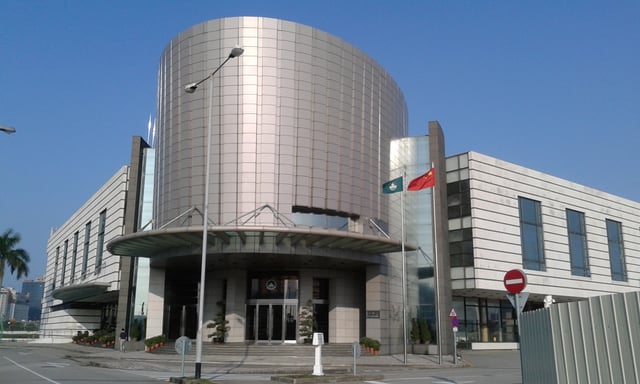
The legislature meets in the Legislative Assembly Building in Sé.
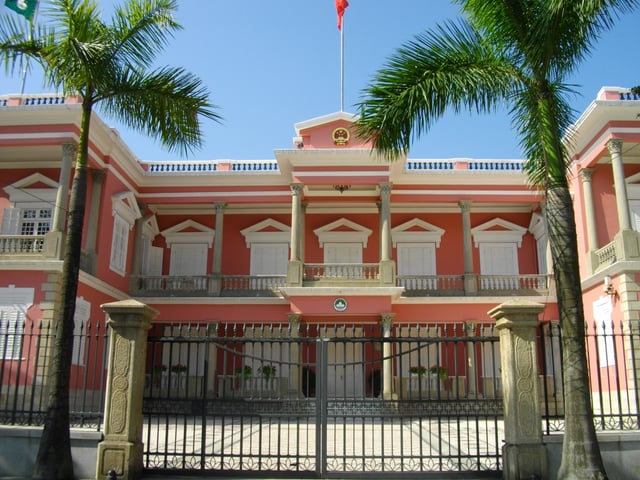
The Macau Government Headquarters is the official office of the Chief Executive.
Macau is a special administrative region of China, with executive, legislative, and judicial powers devolved from the national government.[52] The Sino-Portuguese Joint Declaration provided for economic and administrative continuity through the transfer of sovereignty, resulting in an executive-led governing system largely inherited from the territory's history as a Portuguese colony.[53] Under these terms and the "one country, two systems" principle, the Basic Law of Macao is the regional constitution.[54] Because negotiations for the Joint Declaration and Basic Law began after transitional arrangements for Hong Kong were made, Macau's structure of government is very similar to Hong Kong's.[55]
The regional government is composed of three branches:
Executive: The Chief Executive is responsible for enforcing regional law,[56] can force reconsideration of legislation,[57] and appoints Executive Council members, a portion of the legislature, and principal officials.[56] Acting with the Executive Council, the Chief Executive can propose new bills, issue subordinate legislation,[58] and has authority to dissolve the legislature.[59]
Legislature: The unicameral Legislative Assembly enacts regional law, approves budgets, and has the power to impeach a sitting Chief Executive.[60]
Judiciary: The Court of Final Appeal and lower courts, whose judges are appointed by the Chief Executive on the advice of a recommendation commission,[61] interpret laws and overturn those inconsistent with the Basic Law.[62]
The Legislative Assembly has 33 members, each serving a four-year term: 14 are directly elected, 12 indirectly elected, and 7 appointed by the Chief Executive.[66] Indirectly elected assemblymen are selected from limited electorates representing sectors of the economy or special interest groups.[67] All directly elected members are chosen with proportional representation.[68]
Twelve political parties had representatives elected to the Legislative Assembly in the 2017 election.[69] These parties have aligned themselves into two ideological groups: the pro-establishment (the current government) and pro-democracy camps.[70] Macau is represented in the National People's Congress by 12 deputies chosen through an electoral college, and 29 delegates in the Chinese People's Political Consultative Conference appointed by the central government.[5]
Chinese national law does not generally apply in the region, and Macau is treated as a separate jurisdiction.[52] Its judicial system is based on Portuguese civil law, continuing the legal tradition established during colonial rule. Interpretative and amending power over the Basic Law and jurisdiction over acts of state lie with the central authority, however, making regional courts ultimately subordinate to the mainland's socialist civil law system. Decisions made by the Standing Committee of the National People's Congress can also override territorial judicial processes.[71]
The territory's jurisdictional independence is most apparent in its immigration and taxation policies. The Identification Department issues passports for permanent residents which differ from those of the mainland or Hong Kong, and the region maintains a regulated border with the rest of the country.[72] All travellers between Macau and China and Hong Kong must pass border controls, regardless of nationality.[73] Chinese citizens resident in mainland China do not have the right of abode in Macau, and are subject to immigration controls.[74] Public finances are handled separately from the national government, and taxes levied in Macau do not fund the central authority.[75]
The Macao Garrison is responsible for the region's defence. Although the Chairman of the Central Military Commission is supreme commander of the armed forces,[76] the regional government may request assistance from the garrison.[77] Macau residents are not required to perform military service and current law also has no provision for local enlistment, so its defence force is composed entirely of nonresidents.[78]
The State Council and the Ministry of Foreign Affairs handle diplomatic matters, but Macau retains the ability to maintain separate economic and cultural relations with foreign nations.[79] The territory negotiates its own trade agreements and actively participates in supranational organisations, including agencies of the World Trade Organization and United Nations.[80][81][82] The regional government maintains trade offices in Greater China and other nations.[83]
Administrative divisions
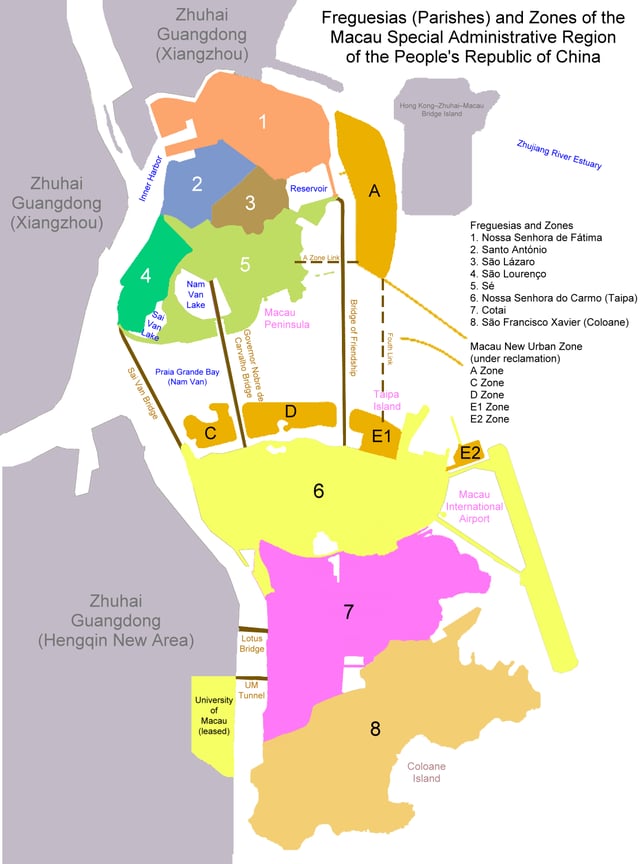
Administrative divisions of Macau
The territory is divided into seven parishes. Cotai, a major area developed on reclaimed land between Taipa and Coloane, and areas of the Macau New Urban Zone do not have defined parishes.[84] Historically, the parishes belonged to one of two municipalities (the Municipality of Macau or the Municipality of Ilhas) that were responsible for administering municipal services. The Civic and Municipal Affairs Bureau superseded the municipalities and is currently responsible for providing local services.[85]
| Parish/Area | Chinese | Area (km2)[84] |
|---|---|---|
| Nossa Senhora de Fátima | 花地瑪堂區 | 3.2 |
| Santo António | 花王堂區 | 1.1 |
| São Lázaro | 望德堂區 | 0.6 |
| São Lourenço | 風順堂區 | 1.0 |
| Sé (including New District Zone B) | 大堂區 (包括新城B區) | 3.4 |
| Nossa Senhora do Carmo (including New District Zone E) | 嘉模堂區 (包括新城E區) | 7.9 |
| São Francisco Xavier | 聖方濟各堂區 | 7.6 |
| Cotai | 路氹填海區 | 6.0 |
| New District Zone A | 新城A區 | 1.4 |
| HZMB Zhuhai-Macau Port | 港珠澳大橋珠澳口岸 | 0.7 |
| University of Macau (Hengqin campus) | 澳門大學 (橫琴校區) | 1.0 |
Geography
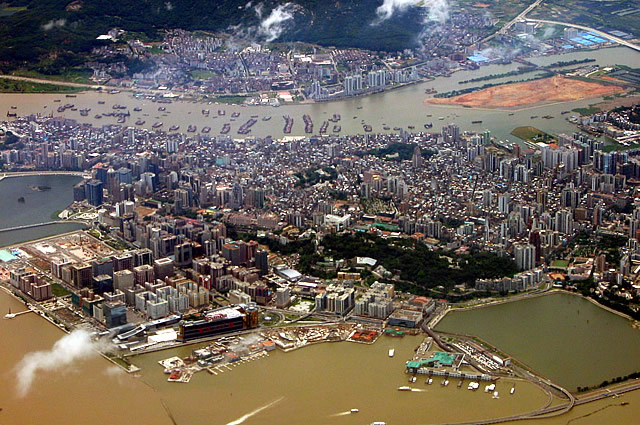
Aerial view of Macau Peninsula
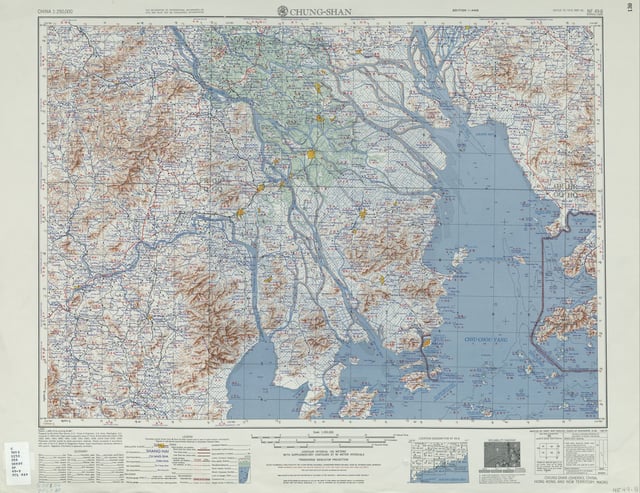
Macau (1954)
Macau is on China's southern coast, 60 km (37 mi) west of Hong Kong, on the western side of the Pearl River estuary. It is surrounded by the South China Sea in the east and south, and neighbours the Guangdong city of Zhuhai to the west and north.[86] The territory consists of Macau Peninsula, Taipa, and Coloane.[87] A 1 km2 (0.39 sq mi) parcel of land in neighbouring Hengqin island that hosts the University of Macau also falls under the regional government's jurisdiction.[88] The territory's highest point is Coloane Alto, 170.6 metres (560 ft) above sea level.[84]
Urban development is concentrated on peninsular Macau, where most of the population lives.[89] The peninsula was originally a separate island with hilly terrain, which gradually became a tombolo as a connecting sandbar formed over time. Both natural sedimentation and land reclamation expanded the area enough to support urban growth.[90] Macau has tripled its land area in the last century, increasing from 10.28 km2 (3.97 sq mi) in the late 19th century[15] to 32.9 km2 (12.7 sq mi) in 2018.[84]
Cotai, the area of reclaimed land connecting Taipa and Coloane, contains many of the newer casinos and resorts established after 1999.[12] The region's jurisdiction over the surrounding sea was greatly expanded in 2015, when it was granted an additional 85 km2 (33 sq mi) of maritime territory by the State Council.[91] Further reclamation is currently underway to develop parts of the Macau New Urban Zone.[92] The territory also has control over part of an artificial island to maintain a border checkpoint for the Hong Kong–Zhuhai–Macau Bridge.[84][93]
Climate

The Macau Peninsula skyline, viewed from Taipa

City view of the Macau Peninsula
Macau has a humid subtropical climate (Köppen Cwa), characteristic of southern China. The territory is dual season dominant – summer (May to September) and winter (November to February) are the longest seasons, while spring (March and April) and autumn (October) are relatively brief periods.[86] The summer monsoon brings warm and humid air from the sea, with the most frequent rainfall occurring during the season. Typhoons also occur most often then, bringing significant spikes in rainfall. During the winter, northern winds from the continent bring dry air and much less rainfall.[94] The highest and lowest temperatures recorded at the Macao Meteorological and Geophysical Bureau are 38.9 °C (102.0 °F) on both 2 July 1930 and 6 July 1930 and −1.8 °C (28.8 °F) on 26 January 1948.[95]
| Climate data for Macau (1981–2010, extremes 1901–present) | |||||||||||||
|---|---|---|---|---|---|---|---|---|---|---|---|---|---|
| Month | Jan | Feb | Mar | Apr | May | Jun | Jul | Aug | Sep | Oct | Nov | Dec | Year |
| Record high °C (°F) | 29.1 (84.4) | 30.2 (86.4) | 31.5 (88.7) | 35.3 (95.5) | 37.5 (99.5) | 36.9 (98.4) | 38.9 (102.0) | 38.5 (101.3) | 38.1 (100.6) | 36.0 (96.8) | 34.2 (93.6) | 30.0 (86.0) | 38.9 (102.0) |
| Average high °C (°F) | 18.2 (64.8) | 18.5 (65.3) | 21.0 (69.8) | 24.7 (76.5) | 28.4 (83.1) | 30.3 (86.5) | 31.6 (88.9) | 31.5 (88.7) | 30.4 (86.7) | 28.1 (82.6) | 24.1 (75.4) | 20.1 (68.2) | 25.6 (78.1) |
| Daily mean °C (°F) | 15.1 (59.2) | 15.8 (60.4) | 18.3 (64.9) | 22.1 (71.8) | 25.6 (78.1) | 27.6 (81.7) | 28.6 (83.5) | 28.4 (83.1) | 27.4 (81.3) | 25.0 (77.0) | 20.9 (69.6) | 16.8 (62.2) | 22.6 (72.7) |
| Average low °C (°F) | 12.5 (54.5) | 13.6 (56.5) | 16.2 (61.2) | 20.2 (68.4) | 23.6 (74.5) | 25.6 (78.1) | 26.2 (79.2) | 26.1 (79.0) | 25.1 (77.2) | 22.6 (72.7) | 18.3 (64.9) | 14.0 (57.2) | 20.3 (68.5) |
| Record low °C (°F) | −1.8 (28.8) | 0.4 (32.7) | 3.2 (37.8) | 8.5 (47.3) | 13.8 (56.8) | 18.5 (65.3) | 19.3 (66.7) | 19.0 (66.2) | 13.2 (55.8) | 9.5 (49.1) | 5.0 (41.0) | 0.0 (32.0) | −1.8 (28.8) |
| Average precipitation mm (inches) | 26.5 (1.04) | 59.5 (2.34) | 89.3 (3.52) | 195.2 (7.69) | 311.1 (12.25) | 363.8 (14.32) | 297.4 (11.71) | 343.1 (13.51) | 219.5 (8.64) | 79.0 (3.11) | 43.7 (1.72) | 30.2 (1.19) | 2,058.1 (81.03) |
| Average precipitation days | 5.5 | 9.9 | 11.7 | 12.0 | 13.9 | 17.7 | 16.0 | 16.0 | 12.3 | 6.1 | 4.6 | 4.5 | 130.2 |
| Average relative humidity (%) | 73.8 | 81.0 | 84.5 | 86.1 | 84.4 | 84.0 | 81.8 | 81.4 | 77.9 | 72.4 | 70.2 | 68.5 | 78.8 |
| Mean monthly sunshine hours | 127.4 | 79.4 | 71.5 | 85.3 | 136.4 | 155.3 | 223.2 | 195.4 | 176.5 | 192.3 | 172.2 | 159.1 | 1,773.9 |
| Source: Macao Meteorological and Geophysical Bureau[96][95] | |||||||||||||
Demographics
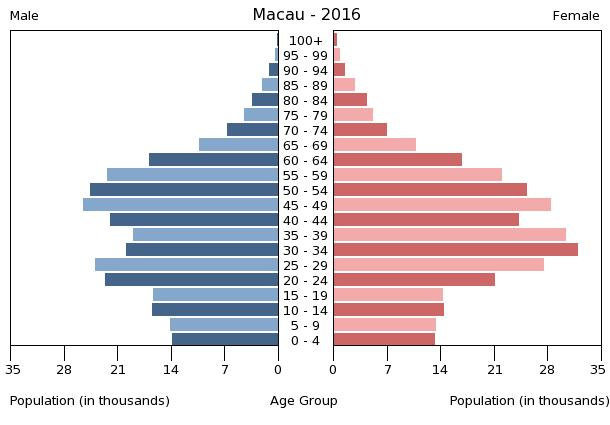
2016 population pyramid
The Statistics and Census Service estimated Macau's population at 667,400 at the end of 2018.[6] With a population density of 21,340 people per square kilometre,[97] Macau is the most densely populated region in the world. The overwhelming majority (88.7 per cent) is Han Chinese, many of whom originate from Guangdong (31.9 per cent) or Fujian (5.9 per cent).[98] The remaining 11.6 per cent are non-ethnic Chinese minorities, primarily Filipinos, Vietnamese, and Portuguese. Macanese, native-born multiracial people with mixed Portuguese ancestry, make up a portion of the Portuguese population.[4] A large portion of the population are Portuguese citizens, a legacy of colonial rule; at the time of the transfer of sovereignty in 1999, 107,000 residents held Portuguese passports.[99]
The predominant language is Cantonese, a variety of Chinese originating in Guangdong. It is spoken by 87.5 per cent of the population, 80.1 per cent as a first language and 7.5 per cent as a second language. Only 2.3 per cent can speak Portuguese, the other official language;[100] 0.7 per cent are native speakers, and 1.6 per cent use it as a second language. Increased immigration from mainland China in recent years has added to the number of Mandarin speakers, making up about half of the population (50.4 per cent); 5.5 per cent are native speakers and 44.9 per cent are second language speakers.[101] Traditional Chinese characters are used in writing, rather than the simplified characters used on the mainland. English is considered an additional working language[102] and is spoken by over a quarter of the population (27.5 per cent); 2.8 per cent are native speakers, and 24.7 per cent speak English as a second language.[101] Macanese Patois, a local creole generally known as Patuá, is now spoken only by a few in the older Macanese community.[103]
Chinese folk religions have the most adherents (58.9 per cent) and are followed by Buddhism (17.3 per cent) and Christianity (7.2 per cent), while 15.4 per cent of the population profess no religious affiliation at all. Small minorities adhering to other religions (less than 1 per cent), including Hinduism, Judaism, and Islam, are also resident in Macau.[104]
Life expectancy in Macau was 81.6 years for males and 87.7 years for females in 2018,[14] the fourth highest in the world.[105] Cancer, heart disease, and respiratory disease are the territory's three leading causes of death. Most government-provided healthcare services are free of charge, though alternative treatment is also heavily subsidised.[106]
Migrant workers living in Macau account for over 25 per cent of the entire workforce.[107] They largely work in lower wage sectors of the economy, including construction, hotels, and restaurants. As a growing proportion of local residents take up employment in the gaming industry, the disparity in income between local and migrant workers has been increasing.[88] Rising living costs have also pushed a large portion of non-resident workers to live in Zhuhai.[107]
Economy
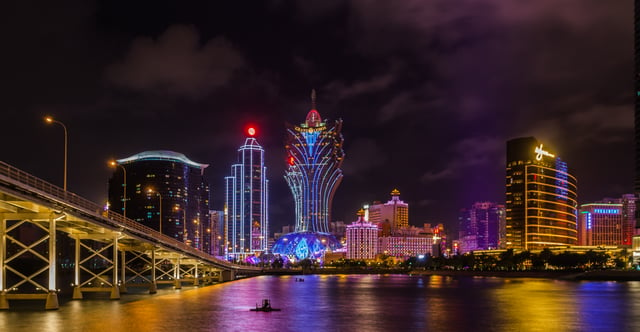
Casinos on the Macau skyline
Macau has a capitalist service economy largely based on casino gaming and tourism. It is the world's 83rd-largest economy, with a nominal GDP of approximately MOP433 billion (US$53.9 billion).[7] Although Macau has one of the highest per capita GDPs, the territory also has a high level of wealth disparity.[12] Macau's gaming industry is the largest in the world, generating over MOP195 billion (US$24 billion) in revenue and about seven times larger than that of Las Vegas.[11]
The regional economy is heavily reliant on casino gaming.[11] The vast majority of government funding (79.6 per cent of total tax revenue) comes from gaming.[108] Gambling as a share of GDP peaked in 2013 at over 60 per cent,[11] and continues to account for 49.1 per cent of total economic output. The vast majority of casino patrons are tourists from mainland China, making up 68 per cent of all visitors.[109] Casino gaming is illegal in both the mainland and Hong Kong, giving Macau a legal monopoly on the industry in China.[11]
Casino gambling was legalised in 1962 and the gaming industry initially operated under a government-licensed monopoly granted to the Sociedade de Turismo e Diversões de Macau. This license was renegotiated and renewed several times before ending in 2002 after 40 years.[110] The government then allowed open bidding for casino licenses to attract foreign investors.[111] Along with an easing of travel restrictions on mainland Chinese visitors, this triggered a period of rapid economic growth; from 1999 to 2016, Macau's gross domestic product multiplied by 7[11] and the unemployment rate dropped from 6.3 to 1.9 per cent.[88] The Sands Macao, Wynn Macau, MGM Macau, and Venetian Macau were all opened during the first decade after liberalisation of casino concessions.[111] Casinos employ about 24 per cent of the total workforce in the region.[88]
Export-oriented manufacturing previously contributed to a much larger share of economic output, peaking at 36.9 per cent of GDP in 1985[112] and falling to less than 1 per cent in 2017.[113] The bulk of these exports were cotton textiles and apparel, but also included toys and electronics.[114] At the transfer of sovereignty in 1999, manufacturing, financial services, construction and real estate, and gaming were the four largest sectors of the economy.[11] Macau's shift to an economic model entirely dependent on gaming caused concern over its overexposure to a single sector, prompting the regional government to attempt re-diversifying its economy.[115]
The government traditionally had a non-interventionist role in the economy and taxes corporations at very low rates.[116] Post-handover administrations have generally been more involved in enhancing social welfare to counter the cyclical nature of the gaming industry.[117] Economic growth has been attributed in large part to the high number of mainlander visits to Macau, and the central government exercises a role in guiding casino business growth through its control of the flow of tourists.[118][119] The Closer Economic Partnership Arrangement formalised a policy of free trade between Macau and mainland China, with each jurisdiction pledging to remove remaining obstacles to trade and cross-boundary investment.[120]
Due to a lack of available land for farming, agriculture is not significant in the economy. Food is exclusively imported to Macau and almost all foreign goods are transshipped through Hong Kong.[121]
Infrastructure
Transport
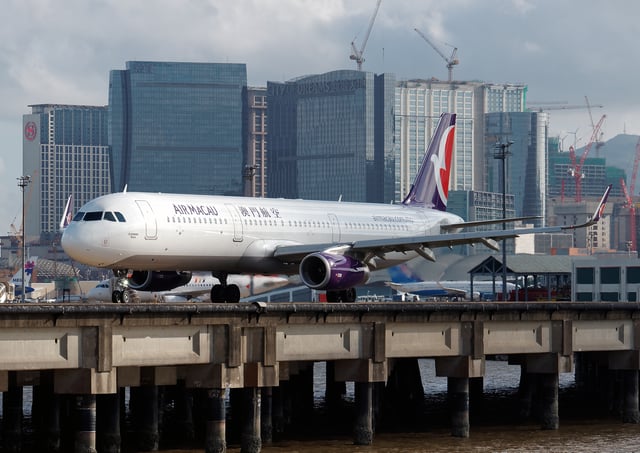
Air Macau Airbus A321 taxiing at Macau International Airport
Macau has a highly developed road system, with over 400 km (250 mi) of road constructed in the territory. Automobiles drive on the left (unlike in both mainland China and Portugal), due to historical influence of the Portuguese Empire.[122] Vehicle traffic is extremely congested, especially within the oldest part of the city, where streets are the most narrow.[123] Public bus services operate over 80 routes, supplemented by free hotel shuttle buses that also run routes to popular tourist attractions and downtown locations.[124] About 1,500 black taxicabs are licensed to carry riders in the territory.[125] The Hong Kong–Zhuhai–Macau Bridge, opened in 2018, provides a direct link with the eastern side of the Pearl River estuary.[126] Cross-boundary traffic to mainland China may also pass through border checkpoints at the Portas do Cerco and Lótus Bridge.[127]
Macau International Airport serves over 8 million passengers each year and is the primary hub for local flag carrier Air Macau.[128] The territory's first rail network, the Macau Light Rapid Transit, is currently under construction and expected to begin operations in 2019. The Taipa line will connect 11 metro stations throughout Taipa and Cotai.[129] Ferry services to Hong Kong and mainland China operate out of Outer Harbour Ferry Terminal, Inner Harbour Ferry Terminal, and Taipa Ferry Terminal. Daily helicopter service is also available to Hong Kong and Shenzhen.[130]
Healthcare
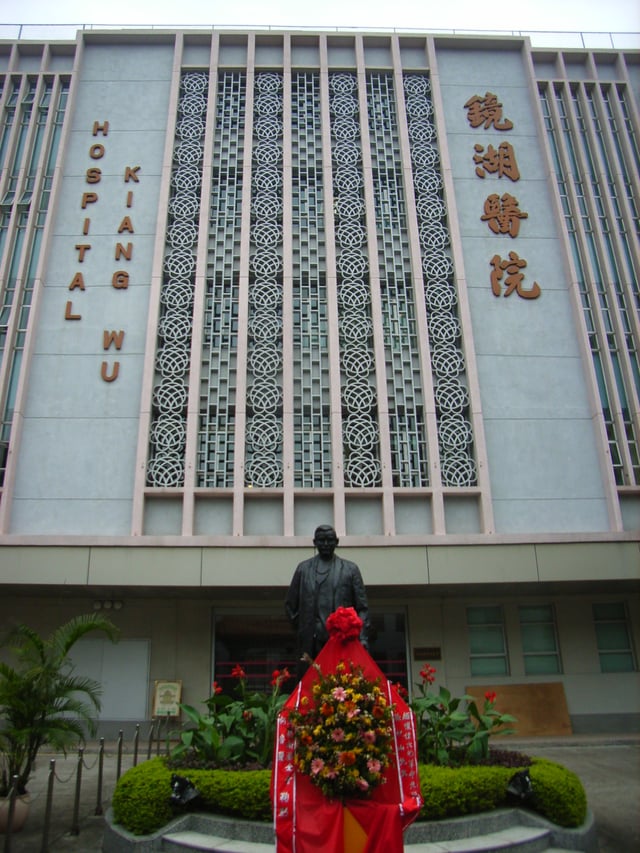
Kiang Wu Hospital
Macau is served by one major public hospital, the Hospital Conde S. Januário, and one major private hospital, the Kiang Wu Hospital, both located in Macau Peninsula, as well as a university associated hospital called Macau University of Science and Technology Hospital in Cotai. In addition to hospitals, Macau also has numerous health centres providing free basic medical care to residents. Consultation in traditional Chinese medicine is also available.[131]
None of the Macau hospitals are independently assessed through international healthcare accreditation. There are no western-style medical schools in Macau, and thus all aspiring physicians in Macau have to obtain their education and qualification elsewhere.[132] Local nurses are trained at the Macau Polytechnic Institute and the Kiang Wu Nursing College.[133][134] Currently there are no training courses in midwifery in Macau. A study by the University of Macau, commissioned by the Macau SAR government, concluded that Macau is too small to have its own medical specialist training centre.[135]
The Macau Corps of Firefighters (Portuguese: Corpo de Bombeiros de Macau) is responsible for ambulance service (Ambulância de Macau). The Macau Red Cross also operates ambulances (Toyota HiAce vans) for emergency and non-emergencies to local hospitals with volunteer staff. The organization has a total of 739 uniformed firefighters and paramedics serving from 7 stations in Macau.[136]
The Health Bureau in Macau is mainly responsible for coordinating the activities between the public and private organizations in the area of public health, and assure the health of citizens through specialized and primary health care services, as well as disease prevention and health promotion.[137] The Macau Centre for Disease Control and Prevention was established in 2001, which monitors the operation of hospitals, health centres, and the blood transfusion centre in Macau. It also handles the organization of care and prevention of diseases affecting the population, sets guidelines for hospitals and private healthcare providers, and issues licences.[138]
As of 2016 Macau healthcare authorities send patients to Queen Mary Hospital in Hong Kong in instances where the local Macau hospitals are not equipped to deal with their scenarios, and many Macau residents intentionally seek healthcare in Hong Kong because they place more trust in Hong Kong doctors than in Mainland-trained doctors operating in Macau.[135]
Education

The main campus of the University of Macau is located in neighbouring Hengqin.
Education in Macau does not have a single centralised set of standards or curriculum. Individual schools follow different educational models, including Chinese, Portuguese, Hong Kong, and British systems.[139] Children are required to attend school from the age of five until completion of lower secondary school, or at age 15. Of residents aged 3 and older, 69 per cent completed lower secondary education, 49 per cent graduated from an upper secondary school, 21 per cent earned a bachelor's degree or higher.[140] Mandatory education has contributed to an adult literacy rate of 96.5 per cent. While lower than that of other developed economies, the rate is due to the influx of refugees from mainland China during the post-war colonial era. Much of the elderly population were not formally educated due to war and poverty.[141]
Most schools in the territory are private institutions. Out of the 77 non-tertiary schools, 10 are public and the other 67 are privately run.[142] The Roman Catholic Diocese of Macau maintains an important position in territorial education, managing 27 primary and secondary schools.[143] The government provides 15 years of free education for all residents enrolled in publicly run schools,[142] and subsidises tuition for students in private schools. Students at the secondary school level studying in neighbouring areas of Guangdong are also eligible for tuition subsidies.[144]
The vast majority of schools use Cantonese as the medium of instruction, with written education in Chinese and compulsory classes in Mandarin. A minority of private schools use English or Portuguese as the primary teaching language. Luso-Chinese schools mainly use Chinese, but additionally require mandatory Portuguese-language classes as part of their curriculum.[139]
Macau has ten universities and tertiary education institutes. The University of Macau, founded in 1981, is the territory's only public comprehensive university. The Kiang Wu Nursing College of Macau is the oldest higher institute, specialising in educating future nursing staff for the college's parent hospital. The University of Saint Joseph, Macau University of Science and Technology, and the City University of Macau were all established in subsequent years. Five other institutes specialise in specific vocations or provide continuing education.[145]
Culture
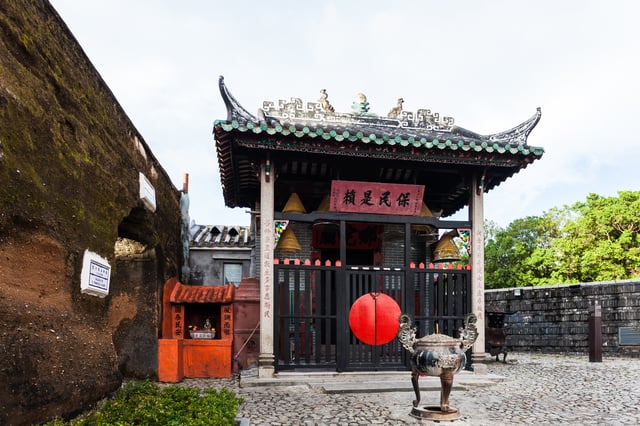
Na Tcha Temple, Macau.
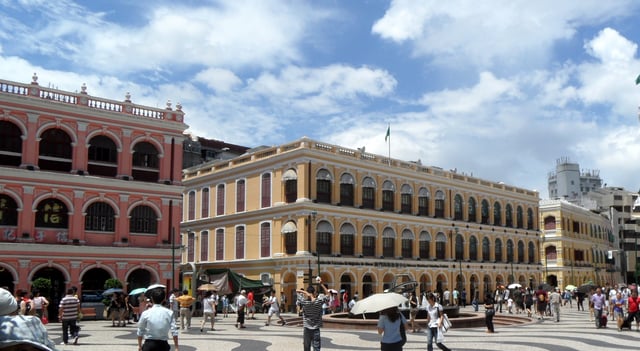
Senado Square.
The mixing of the Chinese and Portuguese cultures and religious traditions for more than four centuries has left Macau with an inimitable collection of holidays, festivals and events. The biggest event of the year is the Macau Grand Prix in November,[146] when the main streets in Macau Peninsula are converted to a racetrack bearing similarities with the Monaco Grand Prix. Other annual events include Macau Arts festival in March, the International Fireworks Display Contest in September, the International Music festival in October and/or November, and the Macau International Marathon in December.
The Lunar Chinese New Year is the most important traditional festival and celebration normally takes place in late January or early February.[147] The Pou Tai Un Temple in Taipa is the place for the Feast of Tou Tei, the Earth god, in February. The Procession of the Passion of Our Lord is a well-known Roman Catholic rite and journey, which travels from Saint Austin's Church to the Cathedral, also taking place in February.[148]
A-Ma Temple, which honours the Goddess Matsu, is in full swing in April with many worshippers celebrating the A-Ma festival. In May it is common to see dancing dragons at the Feast of the Drunken Dragon and twinkling-clean Buddhas at the Feast of the Bathing of Lord Buddha. In Coloane Village, the Taoist god Tam Kong is also honoured on the same day.[148] Dragon Boat festival is brought into play on Nam Van Lake in June and Hungry Ghosts' festival, in late August and/or early September every year. All events and festivities of the year end with Winter Solstice in December.
Macau preserves many historical properties in the urban area. The Historic Centre of Macau, which includes some twenty-five historic locations, was officially listed as a World Heritage Site by UNESCO on 15 July 2005 during the 29th session of the World Heritage Committee, held in Durban, South Africa.[149] However, the Macao government is criticized for ignoring the conservation of heritage in urban planning.[150] In 2007, local residents of Macao wrote a letter to UNESCO complaining about construction projects around world heritage Guia Lighthouse (Focal height 108 meters), including the headquarter of the Liaison Office (91 meters). UNESCO then issued a warning to the Macau government, which led former Chief Executive Edmund Ho to sign a notice regulating height restrictions on buildings around the site.[151] In 2015, the New Macau Association submitted a report to UNESCO claiming that the government had failed to protect Macao's cultural heritage against threats by urban development projects. One of the main examples of the report is that the headquarter of the Liaison Office of the Central People's Government, which is located on the Guia foothill and obstructs the view of the Guia Fortress (one of the world heritages symbols of Macao). One year later, Roni Amelan, a spokesman from UNESCO Press service, said that the UNESCO has asked China for information and is still waiting for a reply.[152][151] In 2016, the Macau government approved an 81-meter construction limit for the residential project, which reportedly goes against the city's regulations on the height of buildings around world heritage site Guia Lighthouse.[151]
Cuisine
Food in Macau is mainly based on both Cantonese and Portuguese cuisine, drawing influences from Indian and Malay dishes as well, reflecting a unique cultural and culinary blend after centuries of colonial rule.[153] Portuguese recipes were adapted to use local ingredients, such as fresh seafood, turmeric, coconut milk, and adzuki beans. These adaptations produced Macanese variations of traditional Portuguese dishes including caldo verde, minchee, and cozido à portuguesa. While many restaurants claim to serve traditional Portuguese or Macanese dishes, most serve a mix of Cantonese-Portuguese fusion cuisine. Galinha à portuguesa is an example of a Chinese dish that draws from Macanese influences, but is not part of Macanese cuisine.[154] Cha chaan teng, a type of fast casual diner originating in Hong Kong that serves that region's interpretation of Western food, are also prevalent in Macau.[155] Pastel de nata, pork chop buns, and almond biscuits are popular street food items.[154]
Sports
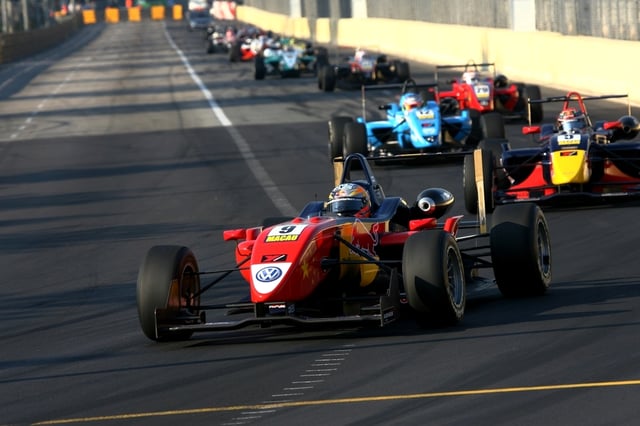
Formula Three racers in the 2008 Macau Grand Prix
Despite its small area, Macau is home to a variety of sports and recreational facilities that have hosted a number of major international sporting events, including the 2005 East Asian Games, the 2006 Lusophony Games, and the 2007 Asian Indoor Games.
The territory regularly hosts the Macau Grand Prix, one of the most significant annual motorsport competitions that uses city streets as the racetrack. It is the only street circuit that hosts Formula Three, touring car, and motorcycle races in the same event. The Guia Circuit, with narrow corner clearance and a winding path, is considered an extremely challenging course and a serious milestone for prospective Formula One racers.[156]
Macau represents itself separately from mainland China with its own sports teams in international competitions. The territory maintains its own National Olympic Committee, but does not compete in the Olympic Games. Current International Olympic Committee rules specify that new NOCs can only be admitted if they represent sovereign states (Hong Kong has participated in the Olympics since before the regulation change in 1996).[157]
Twin towns and sister cities
Additionally, Macau has other cultural agreements with the following cities:
Brussels, Belgium (1991)
San Francisco, United States (2001)
Da Nang, Vietnam (2006)
Phuket, Thailand (2018) [160]
See also
Index of Macau-related articles
Outline of Macau
Cuiheng New Area, since 31 March 2013, a co-operation pilot zone with Macau
